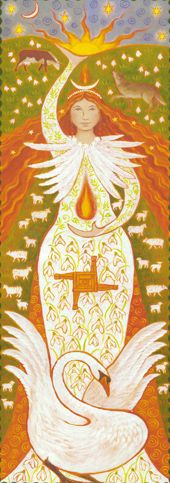Imbolc is Celtic celebration, held on February 1, and is the midpoint between the Winter Solstice and the Spring Equinox. It is a time to let go of the past and to look to the future, clearing out the old, to allow for new beginnings.
The name Imbolc originates from imbolg, meaning ‘in the belly’ and refers to the breeding season and pregnancy of many animals. Bonfires at lit at Imbolc in symbolic gesture of the sun’s return, bringing it into the home hearth.
Imbolc is the festival honouring the Goddess Brigid. She is a Goddess of Fire, of the Sun, of the Hearth of healing, poetry and smithcraft. She brings fertility to the land and its people and is closely connected to midwives and new-born babies. She is the Triple Goddess, but at Imbolc she is in her Maiden aspect. The Christians transformed her to Saint Bridget.
There are many symbols attributed to Brigid and therefore Imbolc such as the snowdrop, the flame, the swan, the serpent, sheep, Brigid’s cross and doll,
The colours associated with Imbolc are white and silver for purity and green for the fresh new life.
Imbolc herbs are blackberry, coltsfoot and ginger.
Another interesting tidbit that I recently discovered is Brigid’s connection to the Goddess Danu.
“The author Felicity Hayes-McCoy links St. Bridget to the Celtic Goddess Danu. The stories associated with St. Bridget are echoes of the ancient story of the Goddess Danu. Danu’s people were tribal Celts who brought her worship with them to Ireland along with their skill as herdsmen and their knowledge of farming crops. Danu was their fertility goddess whose powerful energy revitalised the earth each year in spring. There are stories of seeds waking to the pressure of her feet, and flowers springing up where her cloak touches the fields.
She was a powerful personification of fertility and in Celtic mythology, her marriage to the shining sun god Lugh combined the elements of light, heat and water which brought life to the fields in springtime. Danu’s name means ‘water’. Without water nothing can grow so, for the Celts, she was an image of the essence of life itself. And she’s the prototype of the medieval St. Bridget, who controlled the weather, cured infertility, blessed the housewives’ labour and increased the farmer’s herds.” https://www.newgrange.com/imbolc.htm
I am ever fascinated by the key days on the Celtic Calendar wheel. I hope you enjoyed the facts on Imbolc and that you take a moment to read my previous article about this day.
